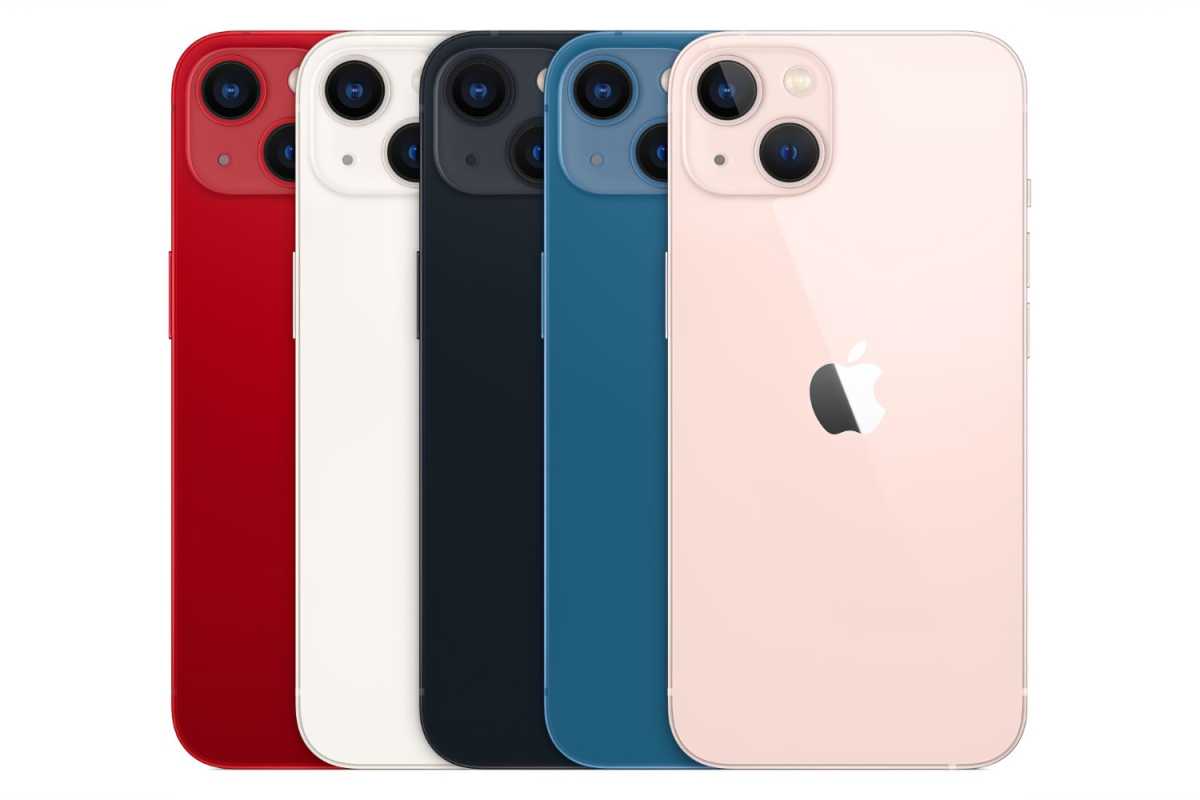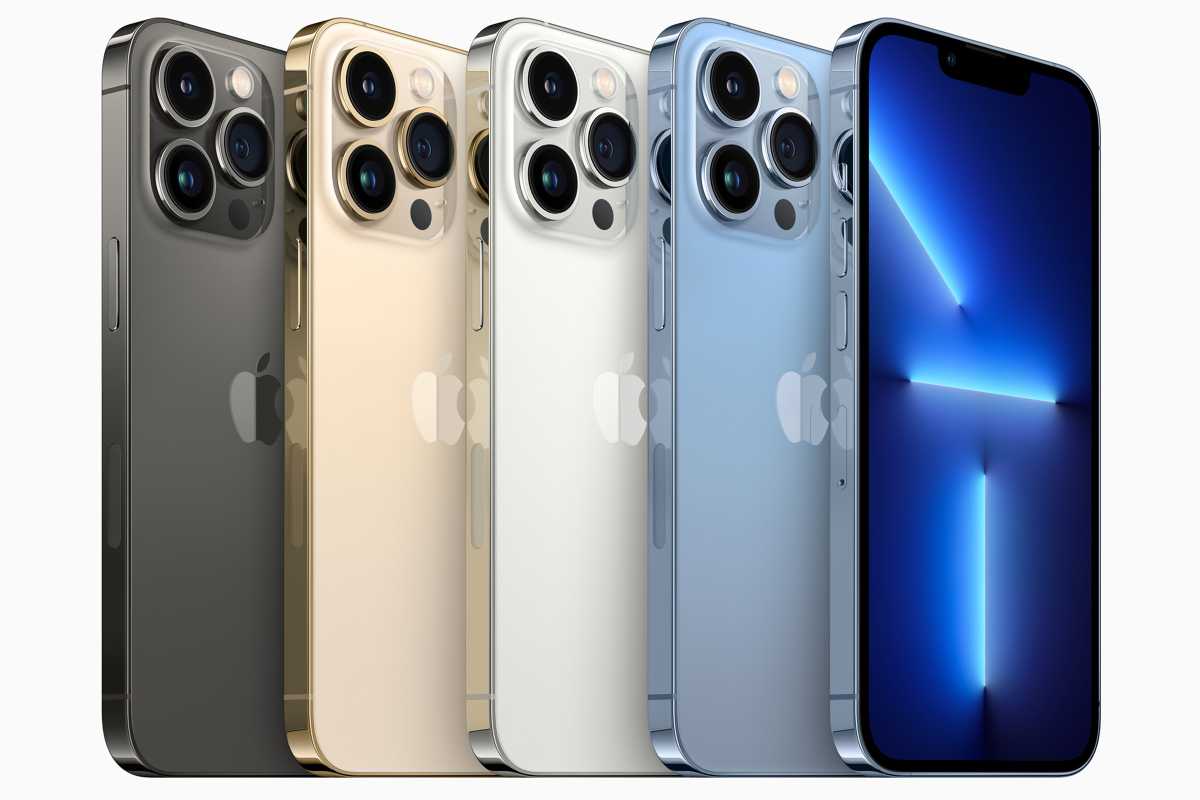On Friday, September 17, the latest iPhones go up for preorder, and they’ll be in stores a week later. Those upgrading or switching have an important choice to make: Buy an iPhone 13 or splurge on an iPhone 13 Pro?
If you want the smallest possible iPhone, the answer is simple—you have no choice but the iPhone 13 mini. You don’t have much choice if you want the biggest iPhone, either—that’s the iPhone 13 Pro Max. But the iPhone 13 and iPhone 13 Pro are the same sizes.
With the iPhone 13 starting at $829 ($799 with carrier activation) and the iPhone 13 Pro starting at $999 (no carrier activation discount), you’ll want to weigh the benefit of the Pro model before deciding if it’s worth spending $200 more. Here are the most significant ways the iPhone 13 and iPhone 13 Pro differ. Needless to say, the iPhone 13 mini shares all the same features as the iPhone 13, and the iPhone 13 Pro Max shares all the same features as the iPhone 13 Pro; the only differences are the size and battery capacity.
iPhone 13 reviews
For in-depth testing of the iPhone 13 Pro, check out our reviews:
iPhone 13 vs. iPhone 13 Pro compared
Do you enjoy your comparisons in table form? We got you!
| iPhone 13 | iPhone 13 Pro | |
|---|---|---|
| Display | 6.1-inch OLED, 800/1200 nits | 6.1-inch OLED, 1000/1200 nits |
| ProMotion | No | Yes |
| Body | Aluminum | Stainless Steel |
| Colors | Starlight, Midnight, Blue, Pink, and (Product)Red. | Silver, Graphite, Gold, and Sierra Blue |
| Size | 5.78″ x 2.82″ x 0.30″ | 5.78″ x 2.82″ x 0.30″ |
| Weight | 6.14 oz (174 grams) | 7.19 oz (204 grams) |
| Processor | A15 – 6 CPU cores, 16 NE cores, 4 GPU cores | A15 – 6 CPU cores, 16 NE cores, 5 GPU cores |
| Durability | IP68, Ceramic Shield | IP68, Ceramic Shield |
| Battery life | 19 hours video playback, 15 hours streaming | 22 hours video playback, 20 hours streaming |
| Cameras | 12MP Wide f/1.6; Ultra-wide f/2.4 | 12MP Wide f/1.5; Ultra-wide f/1.8; 3x Telephoto f/2.8 |
| ProRAW | No | Yes |
| ProRes | No | Yes (with software update) |
| LiDAR | No | Yes |
| Cinematic mode | Yes | Yes |
| 5G | Sub-6GHz and mmWave (in U.S.) | Sub-6GHz and mmWave (in U.S.) |
| Other Wireless Features | Bluetooth 5, Wi-Fi 6 with MIMO, UWB, NFC | Bluetooth 5, Wi-Fi 6 with MIMO, UWB, NFC |
| Storage | 128GB, 256GB, 512GB | 128GB, 256GB, 512GB, 1TB |
| Pricing | From $829 ($799 with carrier activation) | From $999 |
Camera differences galore
The largest differences between the two phones are with the cameras. The iPhone 13 Pro has two rear 12MP cameras: a wide lens with 1.7μ pixels and f/1.6 aperture, and an ultra-wide lens with f/2.4 aperture. Here’s how the two phones stack up:
iPhone 13
Camera 1: 12MP wide, ƒ/1.6
Camera 2: 12MP ultra-wide, ƒ/2.4
iPhone 13 Pro
Camera 1: 12MP Wide, ƒ/1.5 aperture
Camera 2: 12MP ultra-wide, ƒ/1.8
Camera 3: 12MP telephoto, ƒ/2.8
As in prior years, the Pro model adds a telephoto camera as well. This year it’s a 3x zoom with an f/2.8 aperture that supports night mode. The wide camera is also different, with an even larger sensor that has 1.9μ pixels and a wider f/1.5 aperture. The ultra-wide has a much wider f/1.8 aperture. In other words, the Pro should take much better photos in challenging low-light situations and way better zoom from far away. What’s more, the Pro model’s new wide camera has a minimum focus distance of only 2cm, so you can take super close macro photos and video.
Oh, and once again, only the Pro models have LiDAR, which allows you to use portrait mode and night mode together and improves augmented reality (AR) apps. And only the Pro models can also shoot in the ProRAW format introduced last year.
ProRes video recording
Speaking of camera features, while all iPhone 13 models support the new Cinematic Mode and Photographic Styles features, only the Pro models can shoot in ProRes. You likely don’t care much about that unless you’re a video editor, and the feature isn’t going to be available at launch (you’ll have to wait for a software update later this year). And if you want to shoot in 4K at 30 fps, you’ll need to upgrade to at least 256GB. But if the idea of shooting ProRes natively on your iPhone excites you, the Pro is the way to go.
The display on the iPhone 13 is brighter than the iPhone 12, achieving up to 800 nits with SDR content (up to 1,200 with HDR content, just as with the iPhone 12). This is equivalent to the iPhone 12 Pro, and a big improvement over the iPhone 12’s maximum SDR brightness of 625 nits.
But the iPhone 13 Pro goes a step further. It, too, maxes out at 1,200 nits with HDR content, but with SDR content it will go up to 1,000 nits. In normal indoor use, you probably won’t care about the difference between 800 and 1,000 nits—both are too bright—but take your iPhone out into direct sunlight and the Pro model should be a lot easier to see.
It’s ProMotion that will really make the iPhone 13 Pro display stand out, though. While the iPhone 13’s display is fixed at 60Hz like every iPhone before, the ProMotion display on the iPhone 13 Pro can vary its refresh rate from 10Hz to 120Hz, much like the iPad Pro. That will make scrolling and animations super smooth, and touch input latency lower.

Apple
Colors and materials
Like the iPhone 12, the iPhone 13 has an aluminum frame. It comes in five colors: Starlight, Midnight, Blue, Pink, and (Product)Red.
The iPhone 12 Pro has a stainless steel frame like the iPhone 12 Pro, making it a little heavier and more durable. It comes in only four colors: Silver, Graphite, Gold, and Sierra Blue.
Processor and performance
All iPhone 13 models share the same A15 processor. It’s got six CPU cores (two high-performance and four high-efficiency) and 16 Neural Engine cores. Interestingly, though, the Pro models have five GPU cores while the non-Pro models only have four. This is the first time Apple has segmented the iPhone line this way, and it’s quite interesting.
In our testing, we saw benchmark improvements of around 25 percent when comparing the iPhone 13 Pro to the iPhone 13, but it’s difficult to see those gains in real-world use.
Battery life
Apple doesn’t really divulge the battery capacity of their phones, so we have to wait for a teardown to learn specifics. Still, the company says the battery should last longer in the iPhone 13 Pro.
Apple says the iPhone 13 battery should last through 19 hours of video playback, while the iPhone 13 Pro should last 22 hours. That’s just video playback, the iPhone 13 Pro lasts 16 percent longer.
For streaming video, Apple lists the battery life at 15 and 20 hours, respectively. That’s a whopping 33 percent longer!

Apple
Storage
Both the regular and Pro models of the iPhone 13 start at 128GB of storage, with options for 256GB and 512GB. But the iPhone 13 Pro has an option for 1TB as well. It’ll cost you $200 more than the 512GB option, or $500 more than the 128GB option.
Do you need a 1TB phone? I guess that depends on how much ProRes video you plan to shoot.
Which should you buy?
In every other respect—CPU, design, charging, 5G—the iPhone 13 and iPhone 13 Pro are the same. Focusing on the differences has a way of really making the iPhone 13 Pro seem a lot better, but you should consider whether you really care about those features or not. If most of the features don’t seem like the sort of things you care deeply about, you’re just throwing away up to $200 for no good reason.
The difference in battery life, GPU performance, and the experience of the 120Hz ProMotion display are key to the iPhone 13 Pro value proposition. This year’s Pro upgrade is one of the best upgrades in years, both over last year’s iPhone 12 and the entry-level iPhone 13. A $200 difference isn’t small, but the iPhone 13 Pro is worth the extra cost if the camera and display matter to you, especially if you hold on to your iPhone for several years. We recommend paying a little more now to be a lot happier later.
I have written professionally about technology for my entire adult professional life – over 20 years. I like to figure out how complicated technology works and explain it in a way anyone can understand.

